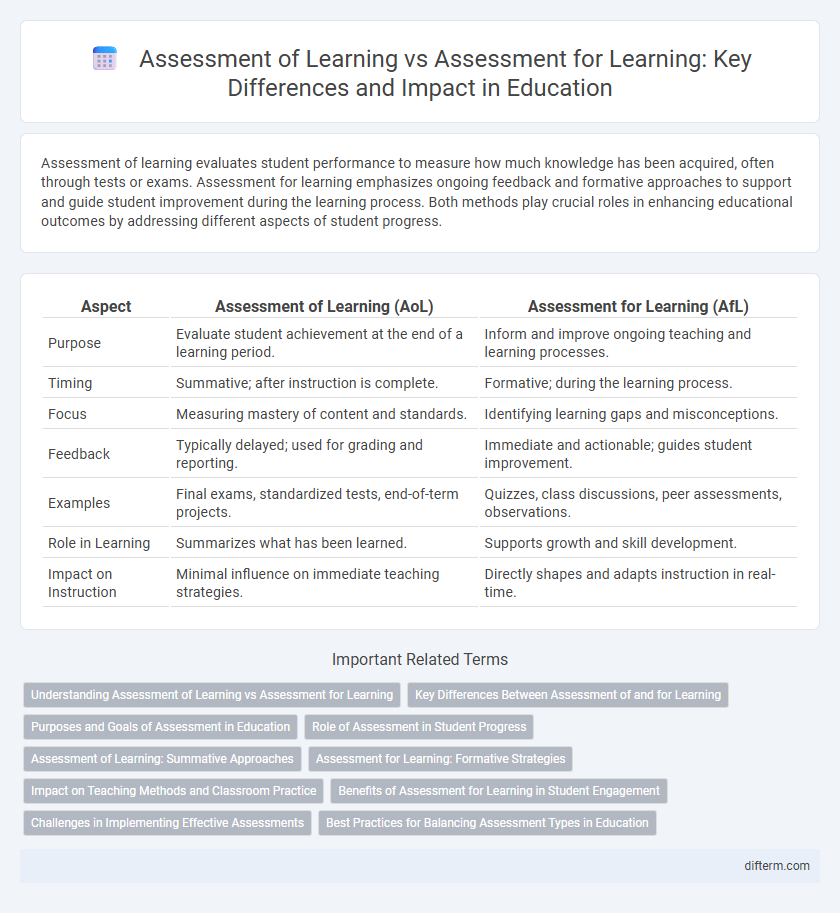Assessment of learning evaluates student performance to measure how much knowledge has been acquired, often through tests or exams. Assessment for learning emphasizes ongoing feedback and formative approaches to support and guide student improvement during the learning process. Both methods play crucial roles in enhancing educational outcomes by addressing different aspects of student progress.
Table of Comparison
| Aspect | Assessment of Learning (AoL) | Assessment for Learning (AfL) |
|---|---|---|
| Purpose | Evaluate student achievement at the end of a learning period. | Inform and improve ongoing teaching and learning processes. |
| Timing | Summative; after instruction is complete. | Formative; during the learning process. |
| Focus | Measuring mastery of content and standards. | Identifying learning gaps and misconceptions. |
| Feedback | Typically delayed; used for grading and reporting. | Immediate and actionable; guides student improvement. |
| Examples | Final exams, standardized tests, end-of-term projects. | Quizzes, class discussions, peer assessments, observations. |
| Role in Learning | Summarizes what has been learned. | Supports growth and skill development. |
| Impact on Instruction | Minimal influence on immediate teaching strategies. | Directly shapes and adapts instruction in real-time. |
Understanding Assessment of Learning vs Assessment for Learning
Assessment of Learning focuses on evaluating student achievement through summative tests designed to measure mastery of curriculum standards, providing data on what students have learned. Assessment for Learning emphasizes formative assessment techniques that actively inform and guide instruction, helping teachers identify student needs and adjust teaching strategies in real time. Understanding these distinct purposes enables educators to balance measuring outcomes with supporting ongoing learning and development.
Key Differences Between Assessment of and for Learning
Assessment of learning primarily focuses on evaluating student achievement through summative tests and exams to measure mastery of curriculum standards. Assessment for learning emphasizes formative feedback, enabling ongoing adjustments to instruction and supporting students' development of skills and knowledge. Key differences include timing--assessment of learning occurs after instruction, while assessment for learning is integrated during the learning process--and purpose, with the former certifying competence and the latter promoting continuous improvement.
Purposes and Goals of Assessment in Education
Assessment of learning primarily aims to evaluate student achievement by measuring knowledge acquisition and skill mastery at the end of an instructional period, providing summative data for grading and accountability. Assessment for learning focuses on formative processes, using ongoing feedback to identify learning gaps and inform instructional strategies, ultimately enhancing student engagement and academic growth. Both assessment types align with educational goals of improving teaching effectiveness and supporting student success through targeted evidence-based practices.
Role of Assessment in Student Progress
Assessment of learning evaluates student achievement by measuring mastery of specific standards, providing summative data essential for grading and accountability. Assessment for learning guides instructional decisions by offering formative feedback that identifies areas for improvement, fostering student self-reflection and growth. Effective integration of both assessments promotes continuous progress by aligning evaluation with teaching strategies and personalized learning goals.
Assessment of Learning: Summative Approaches
Assessment of Learning, primarily summative, evaluates student performance at the end of an instructional period, providing measurable data on achievement against set standards. Common tools include final exams, standardized tests, and end-of-term projects, which quantify knowledge retention and skill acquisition. This approach supports accountability by informing educators, students, and stakeholders about overall learning outcomes and curriculum effectiveness.
Assessment for Learning: Formative Strategies
Assessment for Learning employs formative strategies to monitor student progress and provide ongoing feedback that shapes instruction. Techniques such as questioning, peer assessment, and self-evaluation engage learners actively, promoting deeper understanding and skill development. This approach emphasizes identifying learning gaps early, enabling timely interventions that enhance educational outcomes.
Impact on Teaching Methods and Classroom Practice
Assessment of learning primarily evaluates student achievement at the end of instructional units, informing teachers about the effectiveness of their teaching methods retrospectively. Assessment for learning continuously guides instructional adjustments by providing real-time feedback, fostering a student-centered classroom environment that promotes active engagement and personalized support. Integrating formative assessments encourages adaptive teaching practices, enhancing differentiated instruction and improving overall learning outcomes.
Benefits of Assessment for Learning in Student Engagement
Assessment for learning actively involves students in their educational progress, promoting deeper understanding and intrinsic motivation. This formative approach provides timely feedback, enabling students to identify strengths and areas for improvement, which fosters self-regulated learning. Enhanced student engagement results from a supportive environment where learners participate in setting goals and reflecting on their growth.
Challenges in Implementing Effective Assessments
Challenges in implementing effective assessments stem from balancing assessment of learning, which evaluates student achievement at the end of an instructional period, with assessment for learning, designed to provide ongoing feedback for student improvement. Teachers often face difficulties in designing assessments that accurately measure diverse student abilities while providing actionable insights to guide instructional adjustments. Limited resources, time constraints, and insufficient professional development further complicate the integration of formative assessments into everyday classroom practices, impacting overall educational effectiveness.
Best Practices for Balancing Assessment Types in Education
Effective balancing of assessment of learning and assessment for learning involves integrating summative evaluations with formative feedback to enhance student understanding and retention. Best practices include regularly using formative assessments to guide instructional adjustments while employing summative assessments to measure overall achievement and mastery of standards. Educators should leverage data from both assessment types to create a comprehensive approach that supports personalized learning and continuous improvement.
assessment of learning vs assessment for learning Infographic

 difterm.com
difterm.com